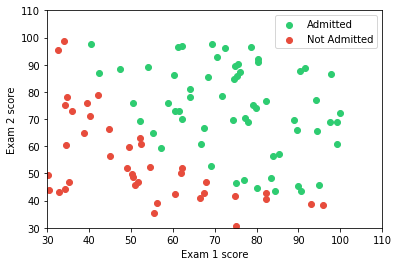Determine each applicant's chance of admission based on their results on two exams. You have historical data from previous applicants that you can use as a training set for logistic regression. For each training example, you have the applicant's scores on two exams and the admissions decision.
| Exam 1 Score | Exam 2 Score | Admission |
|---|---|---|
| 34.62365962451697 | 78.0246928153624 | 0 |
| 30.28671076822607 | 43.89499752400101 | 0 |
| 60.18259938620976 | 86.30855209546826 | 1 |
Now we have to predict chance of getting admission into university (including which is not mention in our example dataset).
Note:This problem statement and dataset is from coursera Andrew ng machine learning Coursework
- jupyter
- scipy
- numpy
- matplotlib
Install dependencies using pip
import numpy as np
import matplotlib.pyplot as plt
# supress scientific value
np.set_printoptions(suppress=True) data = np.loadtxt("ex2data1.txt",dtype=np.float64,delimiter=",")
data[0:5,::]array([[ 34.62365962, 78.02469282, 0. ],
[ 30.28671077, 43.89499752, 0. ],
[ 35.84740877, 72.90219803, 0. ],
[ 60.18259939, 86.3085521 , 1. ],
[ 79.03273605, 75.34437644, 1. ]])
# split data into features and outputs
X = data[::,0:2]
Y = data[::,-1:]# Visualising the Dataset
X_get_admit = np.select([Y==1],[X])
X_not_admit = np.select([Y==0],[X])
plt.xlabel("Exam 1 score")
plt.ylabel("Exam 2 score")
plt.xlim(30,110)
plt.ylim(30,110)
plt.scatter(X_get_admit[::,0:1],X_get_admit[::,-1:],label="Admitted",color="#2ecc71" )
plt.scatter(X_not_admit[::,0:1],X_not_admit[::,-1:],label="Not Admitted",color="#e74c3c")
plt.legend(loc = "upper right",frameon=True)
plt.show()# sigmoid function
def sigmoid(Z):
return (1/(1+np.exp(-Z)))
# hypothesis with sigmoid
def hypothesis(X_bias,Theta):
#here Theta is 1d convert it into 2d
hx = X_bias.dot((Theta.reshape((1,3))).transpose())
return sigmoid(hx)
# cost function
def cost(Theta,X_bias,Y):
m,n = X_bias.shape
hx = (hypothesis(X_bias,Theta))
first = np.multiply(-Y,np.log(hx))
second = np.multiply((1-Y),np.log(1-hx))
return (1.0/m)*np.sum(first - second)m,n = X.shape
Theta = np.zeros(n+1)
X_bias = np.ones((m,n+1))
X_bias[::,1:] = X
cost(Theta,X_bias,Y)0.69314718055994529
# gradient finding method used for advance optimization algorithm
def gradient(Theta,X_bias,Y):
m,n = X_bias.shape
grad = np.zeros(n)
hx = hypothesis(X_bias,Theta)
error = hx -Y
for i in xrange(n):
element = np.multiply(error,X_bias[:,i].reshape((100,1)))
grad[i] = np.sum(element)/len(X_bias)
return grad
gradient(Theta, X_bias, Y)array([ -0.1 , -12.00921659, -11.26284221])
import scipy.optimize as opt
result = opt.fmin_tnc(func=cost, x0=Theta, fprime=gradient, args=(X_bias,Y))
print result(array([-25.16131862, 0.20623159, 0.20147149]), 36, 0)
Theta = result[0]
print Theta # result is 1d array convert it to 2d array for bug free calculation
print Theta.shape[-25.16131862 0.20623159 0.20147149]
(3,)
cost(Theta, X_bias, Y)0.20349770158947456
hx = hypothesis(X_bias,Theta)
# assume 1 if hx >= 0.5 and assume 0 if hx < 0.5
threshold = 0.5
prediction = np.select([hx >= threshold, hx < threshold],[1,0])
final_error = (np.sum(np.absolute(Y-prediction))/len(X))*100
print 'accuracy', (100-final_error),'% with threshold ',thresholdaccuracy 89.0 % with threshold 0.5
# lets try with different threshold
threshold = 0.3
prediction = np.select([hx >= threshold, hx < threshold],[1,0])
final_error = (np.sum(np.absolute(Y-prediction))/len(X))*100
print 'accuracy', (100-final_error),'% with threshold ',thresholdaccuracy 92.0 % with threshold 0.3


